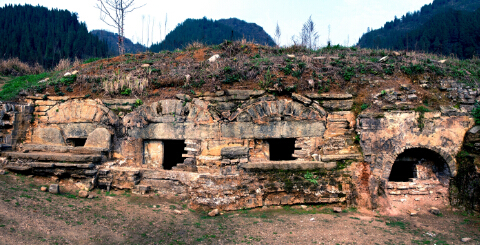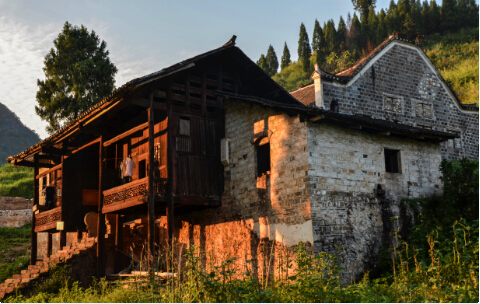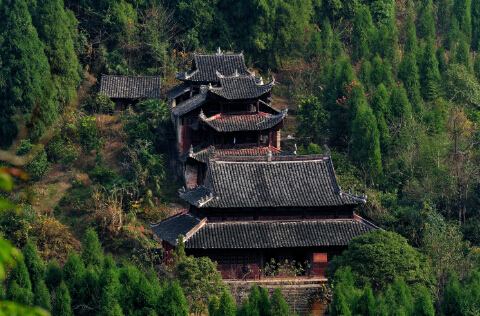 时刻新闻
时刻新闻
—分享—

"Laosicheng did it!" At the 39th session of UNESCO's World Heritage Committee on July 4, the Tusi sites of Laosicheng in Hunan, Tangya in Hubei and Hailongtun Fortress in Guizhou passed deliberation and voting and were inscribed on the World Cultural Heritage List.
For Hunan, it is especially significant in that Laosicheng was the first of its kind to be inscribed on the World Cultural Heritage List.
The Tusi site of Laosicheng in Yongshun, Hunan, located in Laosicheng Village, Lingxi Town that's more than 20km eastern of Yongshun Town, used to be an ancient town ruled by the Tusi regime for 800 years. From the 5th year of the reign of Emperor Shaoxing in the Southern Song Dynasty (1135) to the 6th year of the reign of Emperor Yongzheng in the Qing Dynasty (1724), it was the political, economic, military and cultural center of the Peng Tusi regime in Yongshun.
The Tusi site of Laosicheng covers a total area of 25 square kilometers, of which the town covers 250,000 square meters, and has huge ancient city walls and buildings on the surface. The site is made up of several parts, including the palace district, the government district, the streets, the tomb district, the religious district and the villa district. It was built in a desolate and barren mountainous area with a series of precipitous military passes and defense facilities mainly for a military purpose.
The mysterious Tusi regime was popular for hundreds of years in the Yuan, Ming and Qing dynasties, and reached its prime time in the Ming Dynasty. Throughout the process, the Tusi towns in Hubei set 29 Tusi in the Yuan Dynasty, 31 in the Ming Dynasty, and 20 in the Qing Dynasty.
Areas ruled by Tusi were mostly habited by the minorities. The central governments of the feudal dynasties, in order to strengthen the management of these areas, had taken conciliation policies since the Tang and the Song dynasties, carried out the system of setting government offices in these places to control them, that is, recognizing local nobles, conferring kinghood on them, and involving them into the administration of the central government. Since the Yuan Dynasty, the central governments had been applying the Tusi system of "using barbarous people to subjugate their own races." Till Emperor Hongwu in the Ming Dynasty, it provided that the Tusi "can pass the title to their descendents, has the right of life and death over people, needs to pay tributes to the central government, and shall be ready for requisition at any time."
The inscription of this ancient town on the World Heritage List just brings more glory to it. As the first site in Hunan to be inscribed on the World Heritage List, Laosicheng is of typical significance.
In fact, the aim to bid for the World Heritage List is without doubt to better preserve the cultural sites left by our ancestors. Like Tong Mingkang, deputy director of the State Administration of Cultural Heritage of China, said in an interview with the media, a correct idea must be held in the bid for the World Heritage List, that is, it is for preservation, preservation and preservation.
A means as it is, bidding for the World Heritage List aims to strengthen historical and cultural preservation. Although it can give people a strong sense of honor, such honor is built upon cultural preservation in itself.
In cultural preservation, Laosicheng has done a lot.
In the first half of 2010, Hunan Provincial Institute of Archaeology decided to make the Tusi site of Laosicheng the priority of its archeological work in the following years, and designated Chai Huanbo, the one who explored the site in 1995, to lead the team. In the four years from then to 2014, archaeological excavation and value identification of the site saw major progresses. Mainly, an area of 4,800m2 is excavated for the archaeological purpose an area of 20,000m2 is explored; over 50,000 pieces of cultural relics of different kinds are unearthed; the distribution of each and every function area like the palace district, the government district, the streets, the tombs district, the religious district and the villa district is figured out; and an archaeological report entitled Yongshun Laosicheng is published, providing detailed materials for value studies.

In addition, experts and scholars have made progresses in a number of fields. Scientific research institutes, including Jieshou University, studied 16 key projects on the ancient site of Laosicheng in multiple fields like anthropology, history, ethnology, sociology, anthropology, architecture and folklore; and completed seven research papers, nine monographs and three general reviews, bringing to light the historical and cultural value of the Tusi sites.
However, the most crucial part in the bid for the World Heritage List lies in the relationship between the cultural site and local people.
In April 2010, a new round of archaeological excavation of Laosicheng was initiated, and 22 houses were then covering the site. To ensure the intactness of the site, Yongshun County decided to resettle these 22 farming households to Zhoujiawan Village behind a small mountain ridge. In July the same year, all the households having a good sense of discipline had moved away. Wei Minghu from one of these households said proudly, "We did our part for making Laosicheng a World Heritage site."
Moreover, the local people were even more positive in archaeological excavation. Since 2010, tens of thousands of persons of them participated in the excavation of the Tusi site of Laosicheng. At the most, over 160 workers were skillfully flicking the dust from the site with brushes to part the veil of its mysteriousness.
When the efforts to bid for the World Heritage List expanded from the government to the folks, the folks indeed entered into the work with great strength. Xiang Shengfu, a 73-year-old Tujia national, is a native. After he retired in 2002, Xiang has devoted himself to studying Laosicheng, and has published such books as The Tusi Regime, Rise and Fall of the Tusi System in Xizhou and Folktales in Laosicheng, and wrote two songs, namely The Beautiful Lingxi River and Laosicheng, My Home.
"We did it, and we are reassured." Xiang Shengfu can hardly conceal the excitement and joy inside him. In Laosicheng, cleaners, guards or performers in the folklore culture performance art troupes are doing their respective parts for the successful inscription of Laosicheng on the World Heritage List.

The road of the bid for the World Heritage List is long. Encourage though it is, the success this time is by no means where Laosicheng stops development. It is developing forward.
The first problem would be about development and protection. Like many sites, once an ancient cultural site is involved in the development of tourism, the problem, which has not been satisfyingly settled, is how to demonstrate its vigor and vitality and better preserve it.
But one thing is for sure, for the locals or the tourists, the attractiveness of Laosicheng lies in its originality and uniqueness. Once its historical atmosphere is broken, the development of Laosicheng will inevitably fail.
On the other hand, economic factor can never be made the decisive factor in the development of Laosicheng. In history, there are cases where cultural sites were not well preserved for the pursuit of profits. The Cologne Cathedral in Germany and the heritage sites in Lijiang have been "covered with scratches" after a fast development period of the tourist economy.
Obviously, the principles of the market economy will fail in the development of cultural sites. Unlike general commodities, cultural sites have the cultural values, which even go beyond the economic growth brought about by tourism development. That's why local governments should better play its guiding role therein; help the developers find the best points to combine the preservation of cultural sites with tourism development; and form virtuous cycles of development and preservation.
The Tusi regime with rich cultural deposits has been there after more than 800 years of trials and hardships. The successful inscription of it on the World Heritage List starts a new chapter for Laosicheng. This "pearl" in the mountains in northwest Hunan will lighten up, only that we don't know if it will still be there in centuries.



